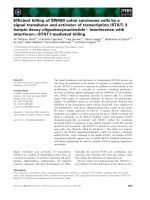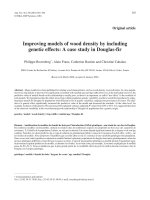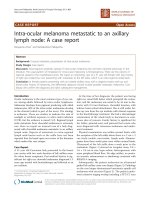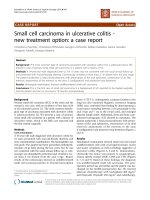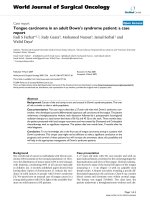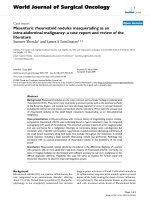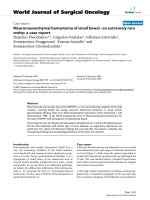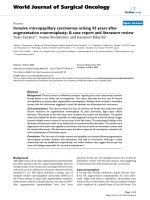Báo cáo khoa học: "Invasive micropapillary carcinomas arising 42 years after augmentation mammoplasty: A case report and literature review" potx
Bạn đang xem bản rút gọn của tài liệu. Xem và tải ngay bản đầy đủ của tài liệu tại đây (704.24 KB, 5 trang )
BioMed Central
Page 1 of 5
(page number not for citation purposes)
World Journal of Surgical Oncology
Open Access
Review
Invasive micropapillary carcinomas arising 42 years after
augmentation mammoplasty: A case report and literature review
Yuko Tanaka*
1
, Isamu Morishima
1
and Kazunori Kikuchi
2
Address:
1
Department of Breast and Thyroid Surgery Tsukuba Medical Center Hospital. 1-3-1, Amakubo, Tsukuba-city, Ibaraki, 305-0005, Japan
and
2
Department of *Pathology, Tsukuba Medical Center Hospital. 1-3-1, Amakubo, Tsukuba-city, Ibaraki, 305-0005, Japan
Email: Yuko Tanaka* - ; Isamu Morishima - ; Kazunori Kikuchi -
* Corresponding author
Abstract
Background: There has been no definitive consensus regarding the causal relationships between
foreign bodies in the breast and carcinogenesis. This report describes the first case of invasive
micropapillary carcinomas after augmentation mammoplasty. Multiple tumors located in immediate
contact with the siliconomas suggested a causal link between the siliconomas and carcinomas.
Case presentation: This report presents the case of a 64-year-old female who underwent liquid
silicone injections for augmentation mammoplasty 42 years previously. Eight years before
admission, siliconomas of the left breast were removed due to pain and discomfort. The patient
visited the hospital for further treatment of newly diagnosed carcinoma of the left breast. Images
showed multiple tumors located in various areas of the left breast. The pathological findings of the
left breast showed each tumor to be solitary and not continuous with the others. The tumors were
diagnosed to be invasive micropapillary carcinomas, and they all came into immediate contact with
the residual siliconomas. The siliconomas were therefore suspected to have played a causative role
in the development of the breast cancer.
Conclusion: This rare case of multiple invasive micropapillary carcinomas following augmentation
mammoplasty provides evidence that siliconomas may lead to carcinomas. Although a causal
relationship was not established unequivocally, we review evidence that suggest silicone gel may
cause cell damage responsible for carcinoma development.
Background
Although breast cancer after augmentation mammoplasty
has been reported and the causal relationships between
foreign bodies in the breast and carcinogenesis have been
reviewed, so far no definitive consensus opinion has been
obtained [1-11]. This report describes a unique case of
multiple invasive micropapillary carcinomas (IMPCs) of
the breast arising 42 years after augmentation mammo-
plasty by the injection of liquid silicone. No cases of IMPC
after augmentation mammoplasty have ever been
reported. In this case, the multiple tumors were located in
immediate contact with the siliconomas, thus suggesting
a link between the siliconomas and the carcinomas.
Case presentation
A 64-year-old woman underwent liquid silicone injec-
tions for augmentation mammoplasty 42 years previ-
ously. Eight years prior to admission, siliconomas were
removed due to discomfort. She visited a hospital with the
chief complaint of a painful mass in her left breast. The
Published: 14 March 2008
World Journal of Surgical Oncology 2008, 6:33 doi:10.1186/1477-7819-6-33
Received: 28 December 2007
Accepted: 14 March 2008
This article is available from: />© 2008 Tanaka et al; licensee BioMed Central Ltd.
This is an Open Access article distributed under the terms of the Creative Commons Attribution License ( />),
which permits unrestricted use, distribution, and reproduction in any medium, provided the original work is properly cited.
World Journal of Surgical Oncology 2008, 6:33 />Page 2 of 5
(page number not for citation purposes)
mass was resected and a histopathological examination
revealed the tumor to be an invasive micropapillary carci-
noma. The surgical margin was positive for malignant
cells and she visited the hospital for further treatment. She
was a healthy-looking woman. The left breast was craggy
and it came in contact with the axilla, which thus made it
difficult to palpate the tumors. No breast tumor was pal-
pable on the other side. The laboratory parameters did not
show any abnormalities and there was no evidence of dis-
tant metastasis. She was not on any medication. She had
never taken oral contraceptives nor received hormonal
therapy. She had experienced three pregnancies and deliv-
ered once. Her family history revealed no malignancies.
A subsequent dynamic magnetic resonance imaging
(MRI) examination with Gadolinium (Gd)-DTPA
enhancement demonstrated the four tumor shadows with
similar enhancement at distant portions. Because it was
unlikely that four malignant tumors existed at the same
instant, they were thus considered to be coexistent malig-
nant tumors and siliconomas. Ultrasonography revealed
masses with an irregular shape and contour, extensive
hypoechogenicity or shadowing. The tumors with a heter-
ogeneous internal echo with a slight degree of Doppler
signaling were considered to be malignant tumors; those
with homogeneous internal hypoechogenicity with no
Doppler signaling were considered to be siliconomas.
A left-sided mastectomy and complete axillary lymph
node dissection was thus performed. The histopathologi-
cal findings of the mastectomy specimen were as follows.
The siliconomas were observed to be spread around the
operational scar. Three tumors were identified, all in
immediate contact with the siliconomas as indicated by
ultrasonography (Figure 1a, b), which measured 12 mm
on the upper side of the breast, 3 mm on the lateral side
and 20 mm on the subareolar area. A tumor measuring 9
mm in diameter was located on the medial side, but had
no connection with the siliconomas (Figure 2). In each
tumor, neoplastic cell clusters floating within clear spaces
defined by a network of loose fibrocollagenous stroma
were recognized (Figure 3a), and the tumors were diag-
nosed as IMPCs. Scirrhous carcinoma components were
also seen in each tumor. The malignant cells of the three
tumors had contact with collections of rounded vacuoles
of varying sizes (Figure 3b). Lipid droplets were contained
in these vacuoles along with macrophages and foreign-
body giant cells. In addition, lymphatic invasion was
observed in all tumors and perineural invasion was seen
for the medial tumor. The tumor in the subareolar area
reached the fat tissues outside of the gland, the dermis and
the larger muscle. Eleven of sixteen axillary lymph nodes
showed tumor involvement. The histological grade, based
on a modified Bloom Richardson scoring system, was
intermediate. The scores for each parameter (tumor
tubule formation, number of mitoses and nuclear pleo-
morphism) were 3, 1 and 2, respectively. Immunohisto-
chemically, the tumors were estrogen receptor (ER) and
progesterone receptor (PgR) positive and C-erbB-2 nega-
tive. Postoperatively, since the patient consistently refused
to be treated with adjuvant systemic chemotherapy, radi-
otherapy was administered with 50Gy to the chest wall.
Subsequently, endocrine therapy was administered using
antiestrogens. Three years after the operation, no metasta-
sis was recognized in any organ.
Discussion
An invasive micropapillary carcinoma (IMPC) was ini-
tially described by Siriaunkgul in 1993, but such a case is
not frequently observed. IMPC is known for its poor clin-
ical outcome, with massive lymph node metastasis and
a) Ultrasonography of the left breast showing the siliconoma (white triangle) and the tumor (black triangle). b) Micro-scopic appearance of the siliconoma and the tumor corre-lated with the ultrasonographic image (hematoxylin-eosin stain, low-power field).Figure 1
a) Ultrasonography of the left breast showing the sili-
conoma (white triangle) and the tumor (black trian-
gle). b) Microscopic appearance of the siliconoma
and the tumor correlated with the ultrasonographic
image (hematoxylin-eosin stain, low-power field).
World Journal of Surgical Oncology 2008, 6:33 />Page 3 of 5
(page number not for citation purposes)
extensive lymphatic invasion [12-14]. There is no clear
explanation for the morphogenesis of this tumor or for
how this particular morphology affects tumor behavior
[15,16]. It is thought to be very rare for multiple foci to
occur together in this subtype of tumor. In this case, three
tumors displayed foci grouping. IMPCs were identified in
approximately 40% of the microscopic field, thus reveal-
ing a mainly scirrhous pattern. Multifocality or multicen-
tricity in breast cancer is defined as the presence of two or
more tumor foci within a single quadrant of the breast, or
within different quadrants of the same breast, respectively
[17]. Determining whether the tumors were multifocal or
multicentric was problematical. Multifocal or multicentric
breast cancer occurring after augmentation has not been
reported. Since the tumors were located in another quad-
rant without ductal continuity, it is therefore highly
unlikely that the metastases occurred through the duct. It
is conceivable that the three tumors metastasized through
the lymphatic system in the breast, although a tumor in
the medial side was assumed to have metastasized
through a perineural route. Considering that three tumors
existed along with the siliconomas, it is very likely that
one of the causes of the development of carcinoma was
the siliconomas or silicone. A report showed that the con-
centration of silicone appeared to be much higher within
the tumor than in the adjacent breast tissue [2]. In the
present case, the most concentrated area, the subareolar,
a) Microscopic appearance of the tumor diagnosed as IMPC (hematoxylin-eosin stain, high-power field), showing neoplas-tic cell clusters floating within clear spaces defined by a net-work of loose fibrocollagenous stroma. b) Microscopic appearance of the siliconoma on the border of the tumor (hematoxylin-eosin stain, high-power field), showing collec-tions of rounded vacuoles with lipid droplets along with mac-rophages and foreign-body giant cells.Figure 3
a) Microscopic appearance of the tumor diagnosed as
IMPC (hematoxylin-eosin stain, high-power field),
showing neoplastic cell clusters floating within clear
spaces defined by a network of loose fibrocollagenous
stroma. b) Microscopic appearance of the siliconoma
on the border of the tumor (hematoxylin-eosin stain,
high-power field), showing collections of rounded
vacuoles with lipid droplets along with macrophages
and foreign-body giant cells.
a) Macroscopic appearance of the left breast specimen. b) Schematic drawing of the breast specimen. Siliconomas were spread extensively within the breast.Figure 2
a) Macroscopic appearance of the left breast speci-
men. b) Schematic drawing of the breast specimen.
Siliconomas were spread extensively within the
breast. Three tumors were identified to come in contact
with the siliconomas.
World Journal of Surgical Oncology 2008, 6:33 />Page 4 of 5
(page number not for citation purposes)
could be a primary site, and cancer cells within the lymph
flow appear to have deviated from usual lymphatic drain-
age pathway due to siliconomas or inflammation, and
then they might have spread to various other regions.
There has been considerable speculation concerning the
safety of breast augmentation, particularly regarding
whether the use of silicone prostheses or silicone is asso-
ciated with an increased risk of carcinoma and/or autoim-
mune disorders and few studies indicate that those who
have undergone mammoplasty are at increased risk of
developing breast cancer. However, in Europe and the
United States, the practice of breast augmentation by the
injection of liquid silicone has been stopped since the
early 1970s and augmentation using bag prostheses now
make up the majority of the augmented population. Epi-
demiological research addressing gel injections has not
yet been performed. Therefore, the proper status of
women augmented by silicone injection may still not be
known. In Japan, the practice of breast augmentation by
injection of liquid silicone was used from 1955 to 1965,
and frequent reports of its complications result in the
abandonment of this procedure in favor of bag prosthe-
ses. Furthermore, augmentation for cosmetic purpose in
Japan is not covered by the health insurance system: there-
fore, there is insufficient medical data on this patient pop-
ulation. However, women who underwent cosmetic
augmentation by silicone injection in the past, did later
show an increased incidence of breast cancer. Among 63
Japanese patients, mammoplasty had been performed by
injection in 41 cases and by implants in 9 cases as far as
we could ascertain. The period from augmentation mam-
moplasty to the diagnosis of breast cancer ranged from 4
months-50 years. In particular, the patient who had previ-
ously undergone liquid silicone injections was diagnosed
to have breast cancer more than 20 years after augmenta-
tion. The dominant histopathological classification was
invasive ductal carcinoma, two cases were ductal carci-
noma in situ, one case was medullary carcinoma and one
case was inflammatory carcinoma.
When breast implants first appeared on the market in
1962, it was assumed that they were biologically inert and
posed no medical risk. However, many reports have indi-
cated a high prevalence of connective tissue disorders and
cancer among implant patients. In contrast, no evidence
has firmly established the long-term safety of breast
implants. Accordingly, the United States Food and Drug
Administration restricted the use of silicone breast
implants to women seeking breast reconstruction in con-
trolled clinical trials. Likewise, the United States Congress
directed the National Institutes of Health to conduct a
large follow-up study to evaluate the long-term health
effects of the implant. No associations were identified
between breast implants and cancer, immunological dis-
eases, neurological problems, or other systemic diseases.
Furthermore, breast cancer risk was not higher for any
type of implant compared to another (e.g., silicone gel
implants, saline-filled implants, double lumen implants,
and other implant varieties) [5].
Results from the National Institutes of Health study are
counterintuitive, in that many lines of evidence indicate
that liquid silicone injections may pose health risks. First,
the liquid silicone used for injection has been shown to
occasionally contain additives which may have some-
times been of a non-medical grade. Second, the physio-
logical response to liquid silicone may be different from
that of vulcanized silicones, such as silicone gels [1]. Fur-
thermore, Felix et al reported the tumorigenicity of sili-
cone gels in the mouse plasmacytoma system [18]. They
showed the possibility that low molecular weight silicone
compounds, such as siloxanes, which are present as the
result of incomplete polymerization in the preparation of
silicone gels, leaking from the complex silicone gel matrix
into the surrounding tissue, may be mutagenic and thus
postulated that this mutagenicity may be a critical deter-
minant of the plasmacytoma inducing potency of silicone
gels. Studies on the stability of silicone gels in vivo have
suggested that the polymeric structure of the gel deterio-
rates with age, thus resulting in the continuous release of
low molecular weight siloxanes from the gel matrix.
Extended exposure to liquid silicone may also have an
unfavorable effect on mammary cells. The other linkage
between mammoplasty and carcinogenesis could have
been chronic inflammation. Chronic inflammation
induced in tissues of other organs including the colon,
stomach, esophagus, gallbladder, urinary bladder and
lung can result in the formation of an adenocarcinoma
[19-21]. Unfortunately, however, there is insufficient data
suggesting a causal relationship between inflammation
and carcinogenesis of the breast [22,23].
With respect to imaging modalities, mammography may
not be a good screening tool in augmented women,
because cancer in augmented women is significantly less
likely to present as a mammographic abnormality in the
absence of physical findings [3,10,24]. Mammography
was impossible for our patient, due to small and contrac-
tural breasts. Ultrasonography with Color Doppler can be
useful for distinguishing cancer from the siliconoma. In
addition, MRI using dynamic Gd-DTPA enhancement was
found to be useful for the diagnosis of breast cancer
because of its high quality and resolution and made it
possible to determine whether a lesion is malignant or not
[3], although it was not possible to diagnose all four
lesions as cancer.
Publish with BioMed Central and every
scientist can read your work free of charge
"BioMed Central will be the most significant development for
disseminating the results of biomedical research in our lifetime."
Sir Paul Nurse, Cancer Research UK
Your research papers will be:
available free of charge to the entire biomedical community
peer reviewed and published immediately upon acceptance
cited in PubMed and archived on PubMed Central
yours — you keep the copyright
Submit your manuscript here:
/>BioMedcentral
World Journal of Surgical Oncology 2008, 6:33 />Page 5 of 5
(page number not for citation purposes)
Conclusion
This report describes that the first case of IMPCs arising
after augmentation mammoplasty. Although the causal
relationship between mammoplasty and carcinogenesis
was not established unequivocally, our review of previous
studies uncovered considerable evidence for deleterious
effects of silicone gel implantation that could be related to
carcinogenesis. We thus consider it likely that the
observed IMPCs were a result of mammoplasty.
Abbreviations
Invasive micropapillary carcinoma; IMPC, magnetic reso-
nance imaging, MRI, estrogen receptor; ER, progesterone
receptor; PgR
Competing interests
The author(s) declare that they have no competing inter-
ests.
Authors' contributions
YT carried out literature search, drafted the manuscript.
IM carried out initial assessment of the patient and helped
in draft of manuscript. KK evaluated histopathological
features and contributed histological part. All authors
read and approved the final manuscript.
Acknowledgements
Written patient's informed consent was obtained for publication of this
report.
References
1. Edelman DA, Grant S, van Os WA: Breast cancer risk among
women using silicone gel breast implants. Int J Fertil 1995,
40:274-280.
2. Maddox A, Schoenfeld A, Sinnett HD, Shousha S: Breast carcinoma
occurring in association with silicone augmentation. Histopa-
thology 1993, 23:379-382.
3. Kasamaki S, Tsurumaru M, Kamano T, Kobayashi S, Hino M, Kawat-
suru R: A case of inflammatory breast cancer following aug-
mentation mammoplasty with silicone gel implants. Breast
cancer 2000, 7:71-74.
4. van Diese PJ, Beekman WH, Hage JJ: Pathology of silicone leakage
from breast implants. J Clin Pathol 1998, 51:493-497.
5. Nelson NJ: Silicone breast implants not linked to breast can-
cer risk. J Natl Cancer Inst 2000, 92:1714-1715.
6. Brinton LA, Brown SL: Breast implants and cancer. J Natl Cancer
Inst 1997, 89:1341-1349.
7. Mclntosh SA, Horgan K: Breast cancer following augmentation
mammoplasty – a review of its impact on prognosis and
management. J Plast Reconstr Aesthet Surg 2007, 60:1127-35.
8. Deapen DM, Hirsch EM, Brody GS: Cancer risk among Los Ange-
les women with cosmetic breast implants. Plast Reconstr Surg
2007, 119:1987-1992.
9. Bryant H, Brasher P: Breast implant and breast cancer – rean-
alysis of a linkage study. N Engl J Med 1995, 332:1535-1539.
10. Skinner KA, Silberman H, Dougherty W, Gamagami P, Waisman J,
Sposto R, Silverstein MJ: Breast cancer after augmentation
mammoplasty. Ann Surg Oncol 2001, 8:138-144.
11. Englert H, Joyner E, McGill N, Chambers P, Horner D, Hunt C,
Makaroff J, O'Connor H, Russell N, March L: Women's health
after plastic surgery. Internal Medecine 2001, 31(2):77-89.
12. Siriaunkgul S, Tavassoli FA:
Invasive micropapillary carcinoma of
the breast. Mod Pathol 1993, 6:660-663.
13. Crus CDL, Moriya T, Endoh M, Watanabe M, Takeyama J, Yang M,
Oguma M, Sakamoto K, Suzuki T, Hirakawa H, Orita Y, Ohuchi N,
Sasano H: Invasive micropapillary carcinoma of the breast:
Clinicopathological and immunohistochemical study. Pathol
Int 2004, 54:90-96.
14. Nassar H, Wallis T, Andea A, Dey J, Adsay V, Visscher D: Clinico-
pathologic Analysis of Invasive Micropapillary Differentia-
tion in Breast Carcinoma. Mod Pathol 2001, 14:836-41.
15. Li YS, Kaneko M, Sakamoto DG, Takeshima Y, Inai K: The reversed
apical pattern of MUC1 expression is characteristics of inva-
sive micropapillary carcinoma of the breast. Breast Cancer
2006, 13:58-63.
16. Nassar H, Pansare V, Zhang H, Che M, Sakr W, Ali-Fehmi R, Grignon
D, Sarkar F, Cheng J, Adsay V: Pathogenesis of invasive micro-
papillary carcinoma: role of MUC1 glycoprotein. Mod Pathol
2004, 17:1045-1050.
17. Coombs NJ, Boyages J: Multifocal and multicentric breast can-
cer: does each focus matter? J Clin Oncol 2005, 23:7497-7502.
18. Felix K, Lin S, Bornkamm GW, Janz S: Tetravinyl-tetramethylcy-
clo-tetrasiloxane (tetravinyl D4) is a mutagen in Rat2λlacI
fibroblasts. Carcinogenesis 1998, 19:315-320.
19. Thun MJ, Henley SJ, Gansler T: Inflammation and cancer: an epi-
demiological perspective. Novartis Found Symp 2004, 256:6-21.
20. Il'yasova D, Colbert LH, Harris TB, Newman AB, Bauer DC, Satter-
field S, Kritchevsky SB: Circulating levels of inflammatory mark-
ers and cancer risk in the health aging and body composition
cohort. Cancer Epidemoil Biomarkers Prev 2005, 14(10):2413-2418.
21. Weitzman SA, Gordon LI: Inflammation and cancer: role of
phagocyte-generated oxidants in carcinogenesis.
Blood 1990,
76:655-63.
22. Zhang SM, Lin J, Cook NR, Lee IM, Manson JE, Buring JE, Ridker PM:
C-reactive protein and risk of breast cancer. J Natl Cancer Inst
2007, 99:890-894.
23. Lithgow D, Nyamathi A, Elashoff D, Martinez-Maza O, Convington C:
C-reactive protein in nipple aspirate fluid: relation to
women's health factor. Nurs Res 2006, 55:418-425.
24. Miglioretti DL, Rutter CM, Geller BM, Cutter G, Barlow WE, Rosen-
berg R, Weaver DL, Taplin SH, Ballard-Barbash R, Carney PA, Yan-
kaskas BC, Kerlikowske K: Effect of breast augmentation on the
accuracy of mammography and cancer characteristics. JAMA
2004, 291:442-450.

